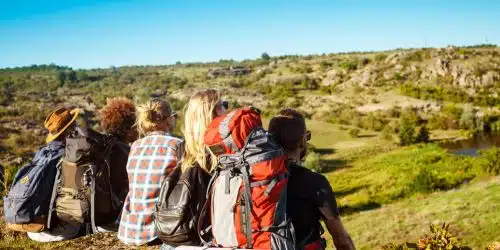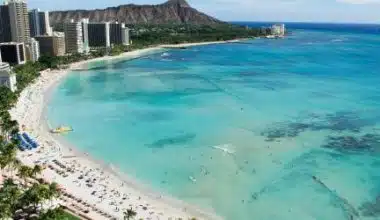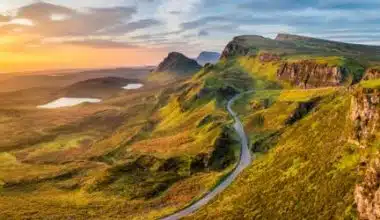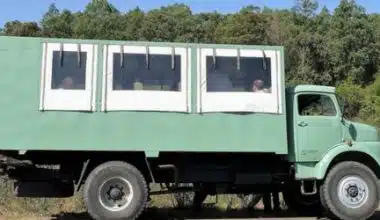Prepare for various amazing trips to Patagonia, a stunning wilderness at the southern tip of South America. With its towering peaks and sparkling lakes, Patagonia offers a breathtaking adventure. This article provides all the information you need to explore this incredible region, putting together the various types of trips, its features, and tips on how to go about trips to Patagonia. Patagonia is an exceptional destination waiting to leave a lasting impression on you. Everyone may find something to enjoy in Patagonia, whether they want to go hiking, trekking, or just enjoying the scenery.
Trips To Patagonia
Patagonia is a vast and stunning region that spans across Chile and Argentina, offering visitors a range of outdoor activities and breathtaking landscapes. Patagonia for hiking, trekking, or simply taking in the natural beauty of the area.
The opulent lodges of Patagonia provide all-inclusive packages that feature roundtrip airport transportation, a variety of full- and half-day excursions, and three gourmet meals each day with fine wine and spirits. With scores of trips in Torres del Paine and Patagonia National Park conducted by knowledgeable guides, visitors have access to a private guide and a four-wheel drive vehicle to explore the surroundings at their own speed. Also, Travelers visiting Patagonia should be prepared for any type of weather.
Various Types Of Trips
There are various types of trips you can take to Patagonia, depending on your interests and preferences. Some common types of trips to Patagonia include:
#1. Adventure Trips
Patagonia is a paradise for adventure enthusiasts. Adventure trips to Patagonia often include activities like hiking, trekking, mountaineering, rock climbing, ice climbing, kayaking, white-water rafting, and zip-lining. These trips are perfect for those seeking an adrenaline-filled experience in the region’s stunning landscapes.
#2. Wildlife and Nature Trips
Patagonia offers diverse wildlife experiences, including national parks, wildlife reserves, and guided hikes, offering opportunities for birdwatching, photography, and spotting.
#3. Cultural and Historical Trips
Patagonia’s cultural and historical history, which was impacted by indigenous peoples and European settlers, provides opportunities for cultural excursions to discover the local way of life, see traditional villages, and visit historical locations.
#4. Photography Trips
Photographers may take advantage of the beautiful scenery, glaciers, mountains, lakes, and wildlife in Patagonia. Photography trips to Patagonia are designed to help you capture the region’s beauty and offer guidance on composition, lighting, and capturing the best shots in different conditions.
#5. Expedition Cruises
Patagonia’s fjords, channels, and coastal areas can be explored through expedition cruises. These cruises take you to remote and less accessible regions, allowing you to witness glaciers, wildlife, and stunning landscapes from the comfort of a ship. Some cruises also offer activities like kayaking and Zodiac boat excursions.
#6. Multi-Country Trips
Patagonia spans both Chile and Argentina, offering the opportunity to explore both sides of the region. Multi-country trips allow you to experience the different landscapes, cultures, and attractions of both countries, from the vibrant cities of Buenos Aires and Santiago to the natural wonders of Torres del Paine and Perito Moreno Glacier.
#7. Scenic Road Trips
One of the best ways to appreciate Patagonia’s amazing views is through a road trip. Take in the beautiful vistas of mountains, lakes, woods, and glaciers as you travel along the well-known Ruta 40 or the Carretera Austral in a rental car or as part of a guided trip.
#8. Horseback Riding Trips
Patagonia is a fantastic destination for horseback riding enthusiasts. You can embark on multi-day horseback riding expeditions, exploring the region’s vast open spaces, crossing rivers, and riding through pristine wilderness.
#9. Fly Fishing Trips
The fly fishing opportunities in Patagonia are world-class. Numerous rivers, lakes, and streams teeming with trout and salmon can be found in the area. Fly fishing trips to Patagonia often include guided fishing excursions, where you can cast your line in some of the most pristine and scenic fishing spots in the world.
#10. Skiing and Snowboarding Trips
During the winter months (June to August), Patagonia offers excellent skiing and snowboarding opportunities. There are several ski resorts in the region, such as Cerro Catedral in Bariloche and Cerro Chapelco in San Martin de los Andes.
Features of Trips to Patagonia
Patagonia is a region that offers visitors a wide range of experiences and activities. Here are some of the features of trips to Patagonia that make it such a popular destination:
#1. Stunning Natural Landscape
The stunning natural splendor of Patagonia, which includes towering mountains, glaciers, fjords, lakes, and huge open plains, is well known.
#2. Hiking and Outdoor Activities
Patagonia offers numerous opportunities for outdoor activities such as hiking, trekking, mountaineering, wildlife watching, kayaking, and more. There are various trails and routes suitable for different skill levels.
#3. Wildlife Encounters
A wide variety of wildlife, including penguins, seals, sea lions, whales, guanacos, foxes, and several bird species, may be found in Patagonia. There may be chances on excursions to see and speak with these animals in their natural settings.
#4. Cultural Experiences
Some trips to Patagonia also include visits to local communities and cultural sites, providing an opportunity to learn about the local culture, traditions, and history of the region.
#5. Professional Guides
Many tours to Patagonia are led by experienced guides who are knowledgeable about the region’s geography, wildlife, and culture. They can provide valuable insights and ensure the safety and enjoyment of the participants.
#6. Accommodation and Transportation
Trips to Patagonia include accommodation options ranging from camping and eco-lodges to hotels and resorts. Transportation between different destinations within Patagonia is often provided as part of the trip.
#7. Educational Opportunities
Trips to Patagonia also include educational components, such as lectures or presentations by experts in the field, to enhance participants’ understanding of the natural and cultural aspects of the region.
#8. Glacier Exploration
Glaciers like the Perito Moreno and Grey Glaciers in Patagonia are world-famous for their beauty. Travelers to Patagonia frequently have the chance to get up close and personal with these glaciers by either trekking on them or taking boat trips.
#9. National Parks
Torres del Paine National Park in Chile and Los Glaciares National Park in Argentina are two of the national parks in Patagonia. These parks include fantastic hiking paths, captivating views, and chances to see wildlife.
#10. Astronomy and Stargazing
Patagonia is a great place for astronomy lovers to visit because it offers some of the clearest skies in the world. Some tours include stargazing activities so that you may take in the beauty of the night sky and discover the celestial bodies.
Tips for Trips to Patagonia
If you’re planning a trip to Patagonia, there are a few things you should keep in mind to make the most of your experience. When planning a trip to Patagonia, it’s important to be prepared for the unique climate and terrain of the region. Check the specific regulations and guidelines for the areas you plan to visit, as rules may vary between national parks and protected areas. Here are some tips to help make your trip to Patagonia a success:
#1. Plan and Book in Advance
Patagonia is a popular destination, especially during the peak travel months of December to February. It’s recommended to plan and book accommodations, transportation, and activities well in advance to secure your desired options.
#2. Pack Essential Gear
There are essential items to pack for your trip to Patagonia. These include a good quality backpack, a headlamp or flashlight, a reusable water filter or purification tablets, sunscreen, insect repellent, and a camera to capture stunning landscapes.
#4. Dress in Layers
Patagonia’s weather can be unpredictable, with temperature fluctuations throughout the day. It’s best to dress in layers so you can adjust your clothing accordingly. Bring thermals, a fleece jacket, waterproof pants, and a waterproof outer layer to protect against wind and rain.
#4. Explore Both Chilean and Argentine Patagonia
Patagonia spans both Chile and Argentina. Explore both sides to experience the diverse landscapes and cultures.
#5. Learn Some Basic Spanish
Although many people in tourist areas speak English, learning some basic Spanish phrases can enhance your experience and help you connect with locals. Simple greetings, ordering food, and asking for directions are useful phrases to know.
#6. Take Precautions for Wildlife Encounters
Patagonia is home to diverse wildlife, including guanacos, pumas, condors, and seals. If you encounter wildlife during your trip, keep a safe distance, avoid feeding or approaching them, and follow any guidelines or instructions given by park rangers or guides.
#7. Prepare for the Wind
Strong winds are common in Patagonia, especially in places like Torres del Paine. Bring a windproof jacket, and a cap that can stay on in blustery weather, and think about packing a buff or scarf for facial protection.
#8. Consider Guided Tours
Consider taking guided tours or hiring local guides if you’re unfamiliar with Patagonia or prefer a planned experience. They can offer helpful advice, guarantee your safety, and enable you to get the most out of your stay in the area.
#9. Be Prepared for Remote Areas
Patagonia contains rural areas with possibly few services and conveniences. In case of unforeseen circumstances, make sure to pack necessities like snacks, a first aid kit, and extra supplies.
#10. Stay Hydrated
The combination of physical activity and the dry Patagonian climate can lead to dehydration. Bring a reusable water bottle and make sure to drink plenty of water throughout the day.
Trips to Patagonia Operators
If you’re planning a trip to Patagonia, you may want to consider booking with a tour operator. Patagonia tour operators can help you plan your itinerary, provide local knowledge and expertise, and ensure that your trip runs smoothly. Here are some of the top Patagonia tour operators to consider
#1. Intrepid Travel
They offer a variety of Patagonia trips ranging from 6 to 15 days, with prices starting at $3,210. Their tours include activities such as hiking and exploring the region’s natural beauty.
#2. TourRadar
They have over 250 Patagonia tour packages available, with options from different tour operators like G Adventures, OneSeed Expeditions, and Intrepid Travel. Prices range from $311 for a 9-day trip to $415 for a 15-day trip.
#3. EcoCamp Patagonia
EcoCamp Patagonia is a unique accommodation and tour operator located in Torres del Paine National Park. They offer a range of experiences, including guided hikes, wildlife spotting, and cultural encounters. Their accommodations are sustainable geodesic domes, providing a close-to-nature experience.
#4. Adventure Vacations
Adventure offers various Patagonia trips, including the popular Torres del Paine W Trek and the Classic Full Circuit. They also offer self-guided options and trips highlighting the Los Glaciares National Park.
#5. Say Hueque
They provide adventure tours in Argentine and Chilean Patagonia, allowing you to explore the legendary landscapes and enjoy exceptional adventures. They offer customizable tours to suit your preferences.
#6. Quasar Expeditions
Quasar Expeditions is a top-rated tour operator specializing in Patagonia trips. They offer a range of adventure tours, including hiking, kayaking, and wildlife watching. They are known for their high-quality service and knowledgeable guides.
#7. Cascada Expediciones
Cascada Expediciones is a locally owned tour operator that focuses on sustainable and eco-friendly tours in Patagonia. They offer a variety of trips, from trekking in Torres del Paine National Park to sailing through the fjords of southern Patagonia.
#8. South America.Travel
South America. Travel offers Patagonia treks, trips, and tours that are great for seniors. They provide customizable tour itineraries that can be adjusted to suit your needs.
#9. Road Scholar
Road Scholar offers educational and immersive tours for seniors, and they have several options for exploring Patagonia. Their programs often include guided hikes, wildlife viewing, and cultural experiences, with a focus on learning and discovery.
#10. Patagonia Adventure Expeditions
Patagonia Adventure Expeditions is a tour operator that focuses on small group tours and customized trips in Patagonia. They offer a variety of activities, including hiking, horseback riding, and glacier exploration.
What is the Best Month to Visit Patagonia?
The best month to visit Patagonia depends on personal preferences and desired activities. December to February (summer) is the high season with milder temperatures and longer days, ideal for hiking and outdoor activities. November and March are shoulder seasons with fewer tourists and good weather. October, April, and winter offer unique experiences with changing landscapes, but the weather can be more unpredictable.
How Much Does it Cost for A Trip to Patagonia?
The cost of a trip to Patagonia depends on travel duration, accommodation choices, activities, and personal preferences. The estimates for hotel costs can range from $1,077 for nearly a month of travel, and a low-budget trip can be around $50 per day per person. Round-trip flights from the US to Patagonia can cost between $800 and $1500. The average price for a 7-day trip ranges from $781 for a solo traveler to $2,630 for a family of four.
Why is the Patagonia Trip so Expensive?
The high cost of a Patagonia trip can be attributed to the remote location, increasing tourism, high-quality gear, seasonal demand, and limited infrastructure in the region. These factors contribute to higher prices for goods and services, making the overall trip more expensive. With proper planning and budgeting, it is possible to find ways to make the trip more affordable.
Where Should I Fly to go to Patagonia?
When traveling to Patagonia, you can fly into different airports depending on whether you’re visiting the Argentine or Chilean side. For Argentine Patagonia, fly into Ezeiza International Airport in Buenos Aires, then take a domestic flight to airports like Aeroparque Jorge Newbery, El Calafate, or Trelew. For Chilean Patagonia, fly into Punta Arenas Airport, or consider Puerto Montt a Balmaceda airport for the northern region. Consider your itinerary and desired attractions when choosing an airport. Cross-border options are also available for visiting both sides of Patagonia.
What Country is Patagonia in?
Patagonia is a region shared between Argentina and Chile. It spans approximately 260,000 square miles in the southernmost part of South America.
What is Patagonia Famous for?
Patagonia is famous for its stunning natural landscapes, including dramatic mountain peaks, massive glaciers, and expansive national parks. It is renowned for attractions like the Perito Moreno Glacier, Torres del Paine National Park, and the Upsala Glacier. Patagonia is also known for its unique wildlife, including penguins, guanacos, and Andean condors. The region offers opportunities for outdoor activities such as trekking, hiking, and wildlife spotting. Patagonia’s beauty and diverse ecosystems make it a popular destination for nature lovers and adventure seekers.
Conclusion
Before planning a trip to Patagonia, one should plan and make a booking in advance, pack essential gear, dress in layers, explore both Chilean and Argentine Patagonia, learn basic Spanish, take precautions for wildlife encounters, prepare for strong winds, consider guided tours, be prepared for remote areas, and stay hydrated. Patagonia is a popular destination, especially during peak travel months from December to February. Essential items include a backpack, headlamp, water filter, sunscreen, insect repellent, and a camera.
- BEST ANTARCTICA TRIPS & TOURS AGENCIES IN 2023-2024
- TOP GUIDED TOURS PACKAGES IN 2023
- BEST PORTUGAL TRIPS AND TOUR PACKAGES
- BEST ITALY VACATION PACKAGES FOR 2023/2024
- Best Solo Travel Tours Companies In 2023-2024






